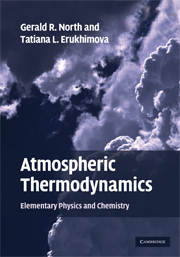Book contents
- Frontmatter
- Contents
- Preface
- 1 Introductory concepts
- 2 Gases
- 3 The First Law of Thermodynamics
- 4 The Second Law of Thermodynamics
- 5 Air and water
- 6 Profiles of the atmosphere
- 7 Thermodynamic charts
- 8 Thermochemistry
- 9 The thermodynamic equation
- Appendix A Units and numerical values of constants
- Appendix B Notation and abbreviations
- Appendix C Answers for selected problems
- Bibliography
- Index
3 - The First Law of Thermodynamics
Published online by Cambridge University Press: 01 February 2010
- Frontmatter
- Contents
- Preface
- 1 Introductory concepts
- 2 Gases
- 3 The First Law of Thermodynamics
- 4 The Second Law of Thermodynamics
- 5 Air and water
- 6 Profiles of the atmosphere
- 7 Thermodynamic charts
- 8 Thermochemistry
- 9 The thermodynamic equation
- Appendix A Units and numerical values of constants
- Appendix B Notation and abbreviations
- Appendix C Answers for selected problems
- Bibliography
- Index
Summary
Often in meteorology we deal with a fixed mass of a gas whose volume and other characteristics may change as the air mass moves about. The particular mass of gas may be thought of as a small parcel of matter that is transported through the environment by natural forces acting upon it. We could also imagine moving it virtually via an abstract thought experiment, for example to determine its stability under small perturbations. As an air parcel rises for whatever reason in the real atmosphere, it will almost instantaneously adapt its internal pressure to the external pressure exerted by the local surroundings, but the temperature and composition adjust more slowly. In convection, entrainment of neighboring air also speeds up the process of equalizing the temperature between inside and outside air. Still there is a huge separation of equalization times between pressure and temperature and/or trace gas concentrations. This time scale separation has made the parcel concept a useful and even powerful tool in the atmospheric sciences. We will return to it often.
Thermodynamics is concerned with the state of a system (an example of which is the parcel alluded to above now treated as an approximate thermodynamic system) and the changes that occur in its state when certain processes occur (such as its being lifted). In the case of a parcel composed of an ideal gas, the state is completely described by the state variables p, V, M and T (actually in equilibrium only three variables need to be specified, since the equation of state in the form of the Ideal Gas Law can be used to calculate the fourth from knowledge of the other three).
- Type
- Chapter
- Information
- Atmospheric ThermodynamicsElementary Physics and Chemistry, pp. 44 - 68Publisher: Cambridge University PressPrint publication year: 2009



